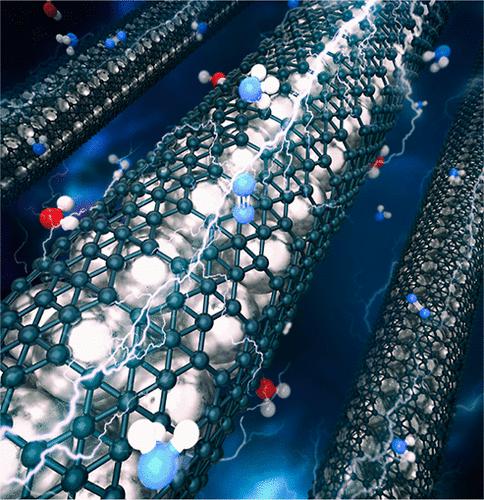当前位置:
X-MOL 学术
›
ACS Appl. Mater. Interfaces
›
论文详情
Our official English website, www.x-mol.net, welcomes your
feedback! (Note: you will need to create a separate account there.)
Regulation of Electronic Structures to Boost Efficient Nitrogen Fixation: Synergistic Effects between Transition Metals and Boron Nanotubes
ACS Applied Materials & Interfaces ( IF 8.3 ) Pub Date : 2022-06-23 , DOI: 10.1021/acsami.2c00501 Changhui Liu 1 , Qingshan Bao 1 , Xian Zhao 2 , Yanlu Li 1
ACS Applied Materials & Interfaces ( IF 8.3 ) Pub Date : 2022-06-23 , DOI: 10.1021/acsami.2c00501 Changhui Liu 1 , Qingshan Bao 1 , Xian Zhao 2 , Yanlu Li 1
Affiliation

|
Borophene possesses outstanding physical and chemical properties and thus demonstrates great application potential in catalysis. However, the lack of a controllable strategy for regulating the electronic structures of borophene for efficient catalysis limits the exploration of this material for a “black-box” model. Herein, taking advantage of the synergistic effects between metals and boron nanotubes (BNT), we report a core–shell structure that encapsulates early transition-metal nanowires into BNT (TMs@BNT) to improve the inherent electronic structures of primitive borophene for an efficient electrochemical nitrogen reduction reaction (eNRR). These filled BNT with disconnected π conjugation and vacant boron (B) pz orbitals enable the regulation of electronic states of B atoms in spatial extent and occupancy that has a great effect on the adsorption strength of intermediates. Using first-principles calculations, we demonstrate that the *N2H adsorption energy (ΔE*N2H) is strongly correlated with the intrinsic activity trends and that the variation of ΔE*N2H is attributed to the distribution of 2p states and charge of B atoms. Finally, we utilize the coupling of the d 2p states between B atoms and metals to obtain a quantitative explanation for synergistic effects and conclude that metals with a lower d-band center (εTM d) raise the average 2p state energy (ε̅2p) of B through two-level quantum coupling, which is the physical origin of this interaction. Therefore, two candidates (Mo@BNT and W@BNT) with lower εTM d are screened, benefiting from their high eNRR activity (limiting potentials of −0.75 and −0.77 V, respectively) and high selectivity. This work explores the activity origin, constructs a bridge between electronic structures and activity trends, and paves the way for future eNRR studies.
中文翻译:

调节电子结构以促进有效固氮:过渡金属和硼纳米管之间的协同效应
硼烯具有优异的物理和化学性质,因此在催化方面显示出巨大的应用潜力。然而,缺乏用于调节硼烯电子结构以实现高效催化的可控策略限制了这种材料在“黑盒”模型中的探索。在这里,利用金属和硼纳米管 (BNT) 之间的协同效应,我们报告了一种核壳结构,将早期过渡金属纳米线封装到 BNT (TMs@BNT) 中,以改善原始硼烯的固有电子结构,从而实现高效电化学氮还原反应(eNRR)。这些用断开的 π 共轭和空硼 (B) p z填充 BNT轨道能够在空间范围和占有率上调节 B 原子的电子态,这对中间体的吸附强度有很大影响。使用第一性原理计算,我们证明*N 2 H 吸附能(Δ E *N 2 H)与内在活性趋势密切相关,并且Δ E *N 2 H的变化归因于2p的分布B原子的状态和电荷。最后,我们利用 B 原子和金属之间 d 2p 态的耦合来获得协同效应的定量解释,并得出结论,具有较低 d 带中心 (ε TM d ) 的金属提高了平均 2p 态能量 (ε̅B 的2p)通过两级量子耦合,这是这种相互作用的物理起源。因此,筛选了具有较低 ε TM d的两个候选物(Mo@BNT 和 W@BNT),这得益于它们的高 eNRR 活性(分别为 -0.75 和 -0.77 V 的限制电位)和高选择性。这项工作探索了活动起源,在电子结构和活动趋势之间架起了一座桥梁,为未来的 eNRR 研究铺平了道路。
更新日期:2022-06-23
中文翻译:

调节电子结构以促进有效固氮:过渡金属和硼纳米管之间的协同效应
硼烯具有优异的物理和化学性质,因此在催化方面显示出巨大的应用潜力。然而,缺乏用于调节硼烯电子结构以实现高效催化的可控策略限制了这种材料在“黑盒”模型中的探索。在这里,利用金属和硼纳米管 (BNT) 之间的协同效应,我们报告了一种核壳结构,将早期过渡金属纳米线封装到 BNT (TMs@BNT) 中,以改善原始硼烯的固有电子结构,从而实现高效电化学氮还原反应(eNRR)。这些用断开的 π 共轭和空硼 (B) p z填充 BNT轨道能够在空间范围和占有率上调节 B 原子的电子态,这对中间体的吸附强度有很大影响。使用第一性原理计算,我们证明*N 2 H 吸附能(Δ E *N 2 H)与内在活性趋势密切相关,并且Δ E *N 2 H的变化归因于2p的分布B原子的状态和电荷。最后,我们利用 B 原子和金属之间 d 2p 态的耦合来获得协同效应的定量解释,并得出结论,具有较低 d 带中心 (ε TM d ) 的金属提高了平均 2p 态能量 (ε̅B 的2p)通过两级量子耦合,这是这种相互作用的物理起源。因此,筛选了具有较低 ε TM d的两个候选物(Mo@BNT 和 W@BNT),这得益于它们的高 eNRR 活性(分别为 -0.75 和 -0.77 V 的限制电位)和高选择性。这项工作探索了活动起源,在电子结构和活动趋势之间架起了一座桥梁,为未来的 eNRR 研究铺平了道路。











































 京公网安备 11010802027423号
京公网安备 11010802027423号